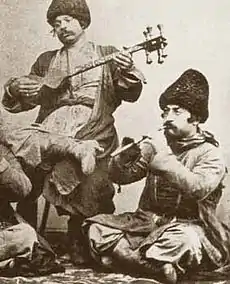Lom people
The Lom people, also known as Bosha by non-Loms (Armenian: Բոշա; Georgian: ბოშა; Russian: Боша; Azeri: Poşa[4]) or Armenian Romani[5] (Russian: армянские цыгане; Armenian: հայ գնչուներ) or Caucasian Romani[5] (Russian: кавказские цыгане), are an ethnic group in historic Armenia.[6] Their Lomavren language is a mixed language, combining Indo-Aryan and Armenian.
 Bosha gypsies, 19th century | |
| Regions with significant populations | |
|---|---|
| 50[1] | |
| 2,000[2] | |
| ~1,000[3] | |
| Languages | |
| Lomavren, Armenian, Georgian, Turkish | |
| Religion | |
| Armenian Apostolic Church, Islam (In Turkey) | |
| Related ethnic groups | |
| other Romani people | |
History
The Lom, like the Dom people, are sometimes considered a separate branch of the proto-Romani people who remained in historic Armenia in the 11th century, while the ancestors of the contemporary Romani migrated further west in the 13th and 14th centuries. The names Dom, Lom and Rom are likely to have the same origin (see Names of the Romani people for details). The Lom are also said to be related to the Lambani people or the Indian Romani; the Lomavren language is also very similar to the Lambani language.
Number
| Year | Armenia | Georgia | Azerbaijan |
|---|---|---|---|
| 1926[7] | |||
| 1939[8] | |||
| 1959[9] | |||
| 1970[10] | |||
| 1979[11] | |||
| 1989[12] | |||
The exact number of existing Bosha is difficult to determine, due to the dispersed and often mostly-assimilated nature of the group. Estimates suggest only a few thousand of the people can be found across Armenia and Georgia, while Government census reports only 50 living in the former.[13]
Distribution
Concentrations of Bosha can be found in Yerevan and Gyumri in Armenia. Some of the Bosha in Armenia have adopted the Armenian language and assimilated with the larger Armenian population.[14] In Georgia they live in such cities as Tbilisi, Kutaisi, Akhalkalaki and Akhaltsikhe. [6] They are noted for such occupations as basket weaving and metalsmithing, which are common among settled Roma. In Turkey they mostly live in Artvin, some families in Ardahan and Kars adopted the Turkish language and assimilated while still using some Armenian words.[3]
See also
References
- "How Indians turned into Armenian Gypsies: Law-abiding and peace-loving". PanARMENIAN.Net.
- "The Gypsies". www.researchgate.net. Retrieved 2020-08-21.
- "Tarihten günümüze Lomlar veya Poşalar". Agos.
- "Ardanuç Poşaları" (PDF). Ahiska.org.tr. Retrieved 9 January 2018.
- Journal / Gypsy Lore Society, Volume 1 University of California, 1908
- "Info on Bosha – Armenian Roma". RomNews Network Community. 2007-10-28. Archived from the original on 2007-10-28. Retrieved 2018-08-10.
- "Демоскоп Weekly - Приложение. Справочник статистических показателей". www.demoscope.ru. Archived from the original on September 26, 2011.
- "Демоскоп Weekly - Приложение. Справочник статистических показателей". www.demoscope.ru. Archived from the original on September 26, 2011.
- "Демоскоп Weekly - Приложение. Справочник статистических показателей". demoscope.ru. Archived from the original on September 26, 2011.
- "Демоскоп Weekly - Приложение. Справочник статистических показателей". www.demoscope.ru. Archived from the original on September 27, 2007.
- "Демоскоп Weekly - Приложение. Справочник статистических показателей". www.demoscope.ru. Archived from the original on September 27, 2007.
- "Демоскоп Weekly - Приложение. Справочник статистических показателей". www.demoscope.ru. Archived from the original on January 4, 2012.
- "POPULATION AND PEOPLE – People – Armenia Travel, History, Archeology & Ecology – TourArmenia – Travel Guide to Armenia". Tacentral.com. Retrieved 9 January 2018.
- Wixman. The Peoples of the USSR. p. 30